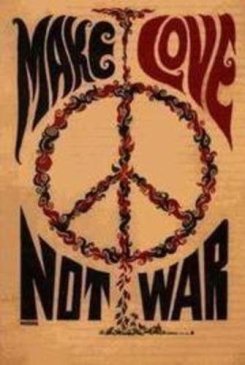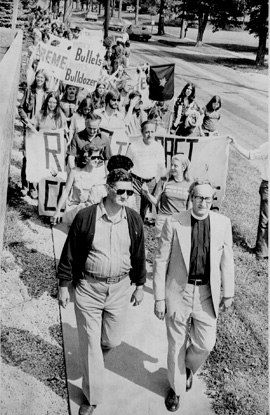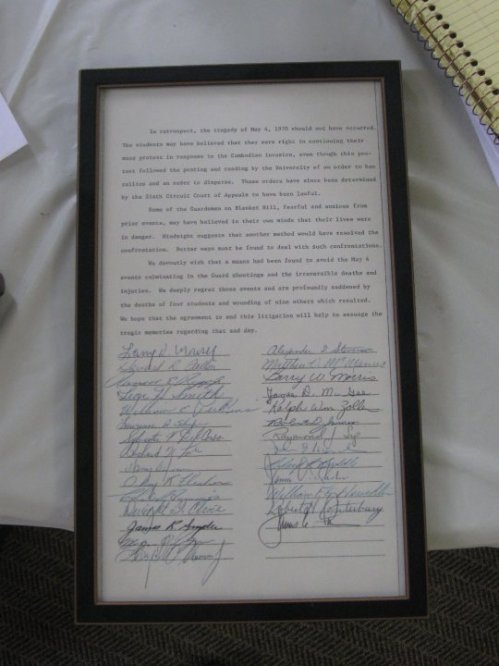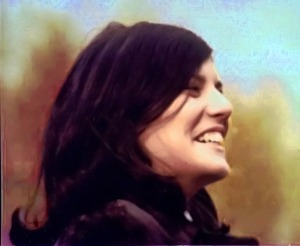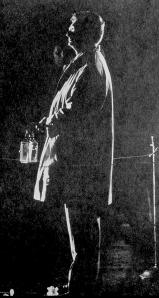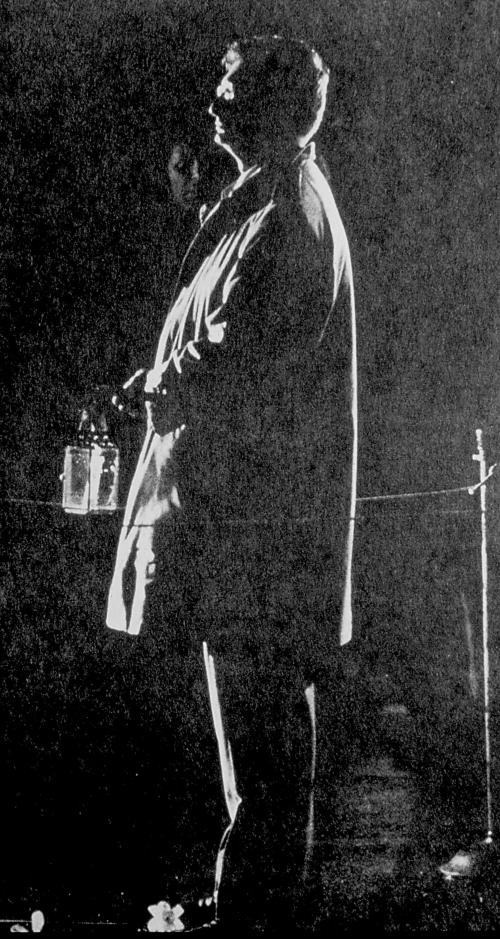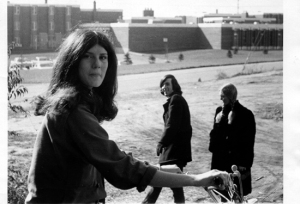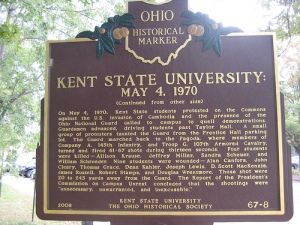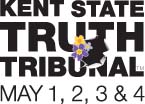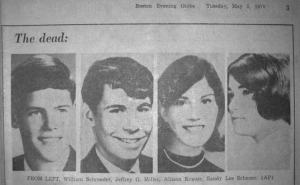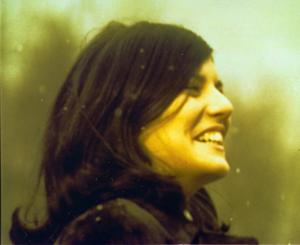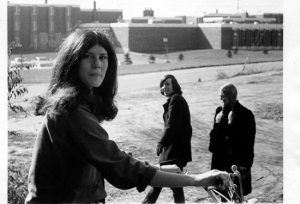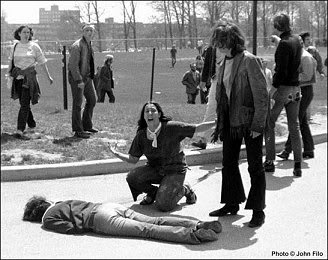— A quote from Stephanie D. Smith, career officer of the Central Intelligence Agency (CIA), named by KSU President Beverly Warren to chair the Kent Massacre 50th anniversary Commemoration Advisory Committee for May 4, 2020
By Mike Alewitz, May 21, 2019
Full disclosure: I was a student antiwar and socialist activist who witnessed the bloodshed of May 4, 1970, when friends and fellow activists were gunned down by Ohio National Guardsmen at Kent State University.
 The appointment of a former CIA kingpin, Stephanie D. Smith, is an affront to the memory of the martyrs of the Kent and Jackson State Massacres and the millions of people that protested the war in Vietnam.
The appointment of a former CIA kingpin, Stephanie D. Smith, is an affront to the memory of the martyrs of the Kent and Jackson State Massacres and the millions of people that protested the war in Vietnam.
According to a KSU press release, Smith, now an associate professor in Kent’s School of Journalism and Mass Communication, “will be a leader in creating, planning and executing all commemoration events, as well as overseeing plans and work with the May 4th Task Force, May 4 families and survivors and Kent State students, staff and faculty.”
Smith has been tasked to “work with the President’s Office and other groups to execute national and global May 4 projects for the commemoration.”
WHO IS CIA OPERATIVE STEPHANIE SMITH?
Stephanie D. Smith was a high-level supervisor of the CIA who retired in 2011, after 25 years of loyal service to the agency.
According to the university, “As a Senior Intelligence Service executive in the CIA, Smith led thousands of employees; designed and managed programs worth several billion dollars; interacted regularly with Congress; and traveled extensively, including throughout two war zones (Afghanistan and Iraq). She was selected as a member of CIA’s Senior Intelligence Service in 2000 and achieved its highest rank.”
Smith served as Executive Director for Administration at the National Security Council under National Security Advisor Condoleezza Rice.
In 2003 she was a part of the leadership team when Rice, Vice President Dick Cheney and Attorney General John Ashcroft planned out and implemented the use of waterboarding, sleep deprivation, forced nudity, sexual assault and other methods of torture used extensively against innocent civilians in Iraq and other locations.
After assisting Rice, Smith was suddenly elevated to Director of the CIA Directorate of Support, the largest section of the CIA, under Executive Director Kyle “Dusty” Foggo.
“I was promoted at a speed that astounded even me…in the process, I came to live by a standard, ‘Get there first and clean up your road kill later,’ Smith said. “If you had observed me during a typical work day, you would never have been able to tell I was a Christian woman,” she added.
In 2008, Dusty Foggo was indicted for illegally steering millions of dollars in CIA contracts to a friend. In the course the investigation, it turns out that he had his mistress (alleged to be Smith) hired to a $100,000 a year job, which explains Smith’s sudden good fortune. She avoided prison by turning state’s evidence against Foggo, after he dumped her for another mistress.
Smith seems remarkably lucky at landing plum jobs – including a professorship at Kent, without having the usually required PhD.
After Foggo was cleared out, Smith ended up at the Counterterrorism Communications Center where she reported to Undersecretary Karen Hughes who “was responsible for trying to polish the image of the US overseas in the wake of the Iraq war and the damaging Abu Ghraib prison abuse scandal.”
And Amy Reynolds, dean of the College of Communication and Information, has the temerity to describe Smith as someone who “cares deeply about what May 4 means to Kent State, to history, to the First Amendment, to activism, to civil discourse, to our students and to the future.”
Smith’s job was cleaning up after the torturers. Out of all the faculty, staff and students that have shown themselves to value human life, this is the person that outgoing President Beverly Warren and incoming President Todd A. Diacon chose to head the commemoration honoring those that fell fighting for peace.
There is nothing accidental about the appointment – it is a message to all that Kent State University is going to spend a year sanitizing the events of May 4, 1970.
WHAT IS THE CIA?
If doing public relations for torturers doesn’t creep you out, it’s worth reviewing what the CIA really does – not the fictional TV version where the good guys capture evil terrorists, but the real story of billions of our tax dollars going to fund death squads, fundamentalist militias and militarist thugs. Stephanie Smith decided to spend her career glorifying them.
In all the world, few organizations are as feared and hated as the US Central Intelligence Agency (CIA). Its sole purpose is to protect global profits for the US ruling class – it is unmatched as a ruthless, terrorist organization.
The CIA has not only been directly responsible for the torture and death of untold thousands of innocent people, it trains and installs the most sadistic henchmen of the world’s bloodiest dictators.
The CIA’s grisly history includes the overthrow of democratically elected governments in places like Iran, Guatemala, Indonesia and the Congo – and the installation and buttressing of the world’s most brutal torture states.
Today, as US warships steam towards Iran, it useful to consider Operation Ajax. This was a US organized coup that replaced the democratically-elected leader of Iran, Prime Minister Mohammed Mossadegh, because of his plans to nationalize the oil industry. Mossadegh was replaced with the Shah, ushering in decades of mass torture. Covert operations and inhuman sanctions continue to this day.
The CIA orchestrated direct military assaults in numerous countries, including the Bay of Pigs invasion of Cuba. During the Vietnam War, the CIA initiated Operation Phoenix, a program that targeted thousands of Vietnamese civilians for assassination, rape, kidnapping and torture.
The CIA has targeted numerous popular leaders for extralegal assassination, including Fidel Castro, Rafael Trujillo and Patrice Lumumba.
In Central America, the CIA was involved in cocaine trafficking to benefit the right-wing terrorist Contras in Nicaragua and promoted fascist Death Squads in El Salvador and Honduras.
Congressional hearings in 1976, revealed that the CIA had been bribing journalists and editors for years.
As we can see by the numerous coups being orchestrated right now in Venezuela, the dirty tricks of the CIA have never stopped – they went on under Smith’s tenure and they are going on now.
WHAT HAPPENED AT KENT
On May 4, 1970, forty-nine years ago, at Kent State University, National Guardsmen fired a barrage of 67 bullets – killing four students and wounding nine more.
In some ways, the atmosphere leading up to the bloodshed is similar to today – with an isolated and increasingly unhinged President engaged in undermining the press and lying to the public.
On April 30th of that year, President Richard Nixon announced the invasion of Cambodia – a major escalation of the war in Southeast Asia. His action sparked widespread outrage. At Kent State, a series of protests, rallies and events took place, including the torching of the ROTC building, a dilapidated wooden structure scheduled for demolition, under suspicious circumstances.
Using that event as a pretext, Governor James Rhodes ordered the Ohio National Guard to occupy the campus. Over the next two days, students were chased, bayoneted and clubbed by guardsmen, tear gas inundated the campus and helicopters with searchlights hovered overhead at night.
Nixon branded the student protesters as “bums.” Rhodes called them “worse than the brown shirts…we will use whatever force necessary to drive them out of Kent!” These inflammatory remarks laid the groundwork for repression.
On May 4, we gathered to protest the war and the military occupation of our university. Guardsmen, armed with live ammunition and firing tear-gas canisters, advanced on the peaceful group. We ran away, but the Guard continued the barrage.
Our gathering was dispersed, and the soldiers began to march away. Suddenly, without provocation, a group of Guardsmen spun around and fired their weapons.
We looked about in disbelief – the victims were unarmed and nowhere near the troops. Allison Krause, who had proudly marched in previous demonstrations, was 330 feet away from the nearest Guardsman, when she was fatally gunned down. A friend, Sandy Scheuer, was 390 feet away, walking to class. She was shot through the neck and killed. Another friend, Robbie Stamps, was almost 500 feet away when wounded.
Four young people lay dead: Allison Krause, Bill Schroeder, Sandy Scheuer and Jeffrey Miller. Among the nine wounded, Dean Kahler was paralyzed for life.
The killings at Kent were followed ten days later with a police barrage of bullets into a dormitory at Jackson State in Mississippi. James Earl Green and Phillip Lafayette Gibbs were gunned down and an unknown number of others were wounded. The African-American victims at Jackson did not receive the same attention as Kent.
GOVERNMENT INVOLVEMENT
To this day, the extent of government involvement in the massacre has never been fully explored. Among the many photos of May 4 are those of a paid FBI informant, Terry Norman, holding a pistol – he is in the crowd. His presence has never been fully explained – the truth of the massacre at Kent remains hidden in the fog of war.
For 49 years the truth has been covered up by the KSU administration, the state and federal governments. This has been a bipartisan effort including both Democratic and Republican politicians at the highest levels of government.
The ROTC building was burned under mysterious circumstances. An armed FBI informant was present. As was later revealed, the FBI was conducting massive and widespread disruption of the anti-war movement through its COINTELPRO program. We know that Lyndon B. Johnson authorized the CIA to undertake its own program of spying on US citizens – Operation Chaos.
The failure to seriously investigate these circumstances constitutes a cover up. We can and should demand an impartial investigation into these events – it’s never too late. We may never know all, but the struggle to find the truth will serve to educate and act as a brake for similar repression.
The warmakers and their academic-administrative toadies fear the truth. They want to continue the coverup of the killings at Kent and Jackson. They want to rewrite the history of US atrocities in Vietnam and around the world – so they may continue to advance their own economic policies of global plunder.
They require the ongoing massacre of the truth.
THE DEBATE AT KENT
Although the press has not yet covered it, there are plenty of people outraged about the appointment of Stephanie Smith. This is not just about the individual – it is about what she represents.
Not only have the events of one day, May 4, been covered up – the larger history of Kent has been re-written as well. The mass anti-war movement, which mobilized thousands of KSU students, along with millions more across the country, has been largely removed from the commemoration programs, exhibits, books and articles.
The demands of our movement: Bring the troops home now! War machine off campus! Free all political prisoners! Money for jobs and education, not war! These and other slogans that expressed our aspirations have been disappeared.
The history of militant student anti-war protest has been airbrushed away. The murders have become a “tragic event” devoid of political content. The commemoration is not about honoring the martyrs that fought against imperialist slaughter – instead it is about looking inward, learning to communicate and having prayers to prevent such unfortunate events in the future.
“Don’t Mourn – Organize”has become “Mourn – Don’t Organize.”
The attempts to suppress and coopt history are hardly unexpected. In capitalist America, colleges and universities are tied to the government through webs of personnel, research, funding, etc. The idea that the KSU administration is an agent of change is wishful thinking.
MAY 4 TASK FORCE
For many years, the May 4 Task Force (M4TF), a student group, organized the yearly commemorations – at times waging important struggles to preserve the memory of the massacre, such as opposing the building of a gymnasium over the shooting site. They did much to educate the student body and keep the memory of May 4 alive.
However, M4TF largely excluded representatives from the mass anti-war organizations – the Student Mobilization Committee Against the War (SMC) was the country’s largest antiwar group and constituted the left wing of the movement – demanding immediate and complete withdrawal of all US forces from Southeast Asia.
The Cleveland Area Peace Action Coalition (CAPAC), the National Peace Action Coalition (NPAC), the New Mobilization Coalition (MOBE) were the central organizations that organized the mass demonstrations and reached out to the working class in trade unions, in the oppressed nationalities and into the armed forces.
These coalitions, that organized millions of people into anti-imperialist actions, were marginalized and excluded from May 4 events and history.
Fantasy histories were invented to fit the needs of a corporate education. One was that Students for a Democratic Society (SDS) and a small group of radicals heroically led a rebellion against the war. It’s true that SDS was a group of radical-minded activists with many dedicated individuals. It called the first march on Washington against the war in 1964 – an important action that broke with the generally pacifist anti-war movement by naming a specific imperialist war.
But 1964 was the last time that SDS, as a national organization, supported a unified national demonstration – opting instead for small-group civil disobedience and individual acts of resistance.
Despite its national abstention, at Kent there were many SDSers that, as individuals, played an invaluable role in educating and mobilizing for mass demonstrations like the 1969 Moratoriums that resulted in thousands of KSU students participating in marches and rallies.
But by creating this mythological history, it removes the participation of thousands of Kent students from antiwar actions. It attempts to make us observers, instead of participants.
Before the shootings on May 4, thousands of KSU marched in anti-war and civil liberties demonstrations. They, and millions like them, changed the course of history.
THE DEMOCRATIC PARTY
The leading figure in the M4TF over the past decades is Alan Canfora, who was shot in the wrist on May 4. He was famously seen waving a black flag at the Guardsmen. Canfora deserves credit for his many years of work on behalf of the M4TF, the families and victims of the shooting.
Canfora is a longtime Democratic Party official in Barberton, Ohio – a Clinton supporter in the center-right of the party. Regarding the development of a left wing in the party, he states his views forthrightly on his Facebook page:
“Putin and his bitches: Bernie Sanders, Donald Trump and Jill Stein. All hail Putin, mastermind of world politics, now it’s clear he owns Bernie, The Donald and Jill.”
Through longevity and consistent self-promotion, Canfora established himself as the leading voice of M4TF, along with his sister Roseann “Chic” Canfora, an adjunct professor and colleague of Stephanie Smith in the School of Journalism, as well as a small coterie of liberal supporters of Democratic Party candidates.
More than anything, this grouping is insistent that any questioning about possible covert governmental involvement in the massacre be dismissed as conspiratorialist – because it raises the responsibility of the Democratic Party in the decades-long cover-up.
None of this has ever mattered much until now. I believe they are making a profound mistake by aligning themselves with the CIA and KSU administration.
The M4TF, which previously had a symbiotic relationship with KSU, has now relinquished complete control of the commemoration and handed it over to the administration. For their part, the administration is attempting to co-opt a handful of M4TF activists – rewarding them with invitations to dine with President Beverly Warren and the trustees, attend meetings, be part of a corporate speaker’s bureau and get some public attaboys.
It was after taking control of the commemoration, and with key M4TF leaders on board, Warren promptly named CIA agent Smith to head up the commemoration.
KSU is attempting to promote itself as a leading research institution – the appointment of Smith is a message to corporate, military and government officials that KSU is open for business and will not be bothered by pesky remembrances of the antiwar movement.
STONEWALLING AND EXCUSES
To date, KSU administrators have not responded to demands that Smith be dumped – leaving defense of the CIA to the Democratic Party clique. Despite very fundamental political disagreements, it saddens me to see some of these activists left holding the bag to defend the CIA, no small task. So far, the justifications of those that defend the CIA operative are these:
Justification: You don’t know her, I do, and she is a good person.
Not all CIA officials are right-wing ideologues. The CIA has often adopted a mantle of progressive politics, even expressing a wish to help groups – that is how they infiltrate unions, student groups and other left organizations. For example, this was how liberal feminist icon Gloria Steinem was recruited to spy on radical activists in Europe.
There are CIA snoops that are nice, personable and funny – just as there are generals, arms dealers and warmakers that seem nice, personable and funny. Henry Kissinger was considered a charmer in the 70s – he dated Hollywood starlets.
Justification: You are not from Kent or have not been involved in the May 4 Task Force, so your opinion doesn’t matter.
After the shootings in 1970, you could already see a cottage industry beginning to grow up around the massacre. There was the emergence of Kent “experts,” most of whom had been marginally involved in the antiwar movement, if at all.
Knowledge of the on-the-ground May 4 events is important, but the broader context of the war and the antiwar movement is critical. Pandering to “experts” and baiting movement activists that have moved on with their lives and do not relate directly to the campus is counter-productive.
To their credit, and as recently documented in Tom Grace’s book about the Kent Massacre, many activists of the time became active in the emerging social movements of the 70s until today – working in solidarity with struggles in Central America, in the Iraq anti-war movement, in the feminist movement and a myriad of other social justice issues.
May 4 does not belong to any one group. The children in Cuba that named their school The Martyrs of Kent School are part of our movement. The people that participated in the Kent Truth Tribunal are part of it. The anti-war activists that sponsor Kent events around the country are part of it. The millions of people that protested the massacre over all these years are part of it.
The young person that got involved just yesterday is part of it – perhaps most importantly of all. The history of the working class and its allies belongs to the class as a whole.
Justification: We’ve been part of the commemoration activities for a long time so you should trust us.
The history of the labor and other social movements has continually shown us that blind trust has no place in the movement or in the university. People change. Groups change. Regardless of past accomplishments, you should be judged by what you say and do now.
Justification: I am a victim/survivor/family/witness, so I get to decide, and I like Stephanie Smith.
No, you are due consideration like everyone else.
In my travels as an agitprop muralist, I’ve seen the result of CIA initiated embargoes, sanctions, sabotage, dirty tricks and US military actions in places like Nicaragua, Cuba, Iraq and Palestine.
Hundreds of thousands of children and elderly have died for lack of medications because of economic sanctions. The mothers of Venezuela or Iran or a dozen other countries whose children suffer and die because of the CIA are also victims. The countless torture casualties in places like Nicaragua are victims. Would you tell them how nice the CIA lady is?
The martyrs of the anti-war and anti-racist movements deserve better than the grotesque mockery of a representative of the repressive apparatus officiating at the commemoration.
This will not go away. We would not be silenced in 1970 and we will not be silenced now.
While it is unfortunate that some individuals have decided to align themselves with the KSU administration and the CIA, keep in mind that they are not responsible for the CIA recruitment on campus or the appointment of Smith.
It is outgoing President Beverly Warren, incoming President Todd A. Diacon and the Board of Trustees that are responsible for this travesty and must be held to account.
THE 1970 NATIONAL STUDENT STRIKE
The KSU administration has purportedly earmarked $2m for an extensive, yearlong series of activities about May 4. It is unlikely that the festivities will honor the true legacy of the antiwar movement and how it transformed society.
The shootings at Kent sparked an unprecedented national student strike – hundreds of thousands of students stopped business as usual. At least 400 campuses were struck – many were occupied, and students began to form strike councils to take control of the universities.
Students began meeting, discussing, debating, creating and using their campuses as a base for organizing – reaching deep into the heart of the country with their anti-war message. We provided support to the thousands of active-duty anti-war GIs that became a key factor in ultimately compelling the US to withdraw from Southeast Asia.
On May 7, 1970, at a Washington, D. C. press conference, I gave a statement on behalf of the Kent Student Mobilization Committee (SMC), along with strike leaders from Berkeley, Wayne State, Case Western Reserve and Tufts. We called for it to be introduced and adopted in student strike councils across the nation. It read in part:
We call on the campus communities now in control of campus facilities to maintain that control and to preserve the broadest student-faculty unity in the face of all attempts to divide them.
We call on the campus communities that have not yet taken control of their campus facilities to do so and to join with their sisters and brothers across the country in utilizing the facilities to mobilize non-campus communities against the war.
We call on the united campus communities to reach out into all communities- into the neighborhoods, the labor unions, the Afro-American and other Third World organizations, the churches and synagogues, the women’s groups, the political associations, the military installations – and organize the new, united antiwar movement that will have the power to actually compel an end to the killing abroad as well as at home.
That proposal for mass actions and occupations stood in stark contrast to calls for individual resistance or toothless electoral activity. Instead, it advanced a national course of action to fundamentally challenge the power of the warmakers.
We were fighting for the empowerment of students and workers. That history is unlikely to be included in the 2020 May 4 events.
THE STRUGGLE AHEAD
The decade-long struggle over Vietnam proved that only a massive movement could end the war. Then, as now, peace did not come from a government that is without compassion or vision – wars and occupations cannot be ended by a timid and impotent legislature that continues to fund the war machine.
Today, the “resistance” of Democratic Party officials is a toothless sound bite. The “progressive” candidates talk peace while voting to fund US military adventures abroad. They cover up their support to the war on workers abroad by giving lip service to some tepid reforms here at home.
Over the next year, there will not only be numerous commemorative events about Kent. Millions of dollars were also allocated to the Pentagon by the Obama White House to commemorate the war in Vietnam. These millions will be utilized to obscure the truth about U.S. involvement in Southeast Asia and repression here at home.
The real history of the genocidal war will be suppressed. There will be little place for truth, or even facts. The unprecedented assault on Julian Assange should remind us how much the warmakers fear the truth.
Fifty years have passed, and the stakes facing working people are greater than at any time in human history. Today, along with rising nationalism and permanent war, we face nothing less than the extinction of our species in a carbon-based nightmare of climate change denial.
As in 1970, our hope for a more peaceful future lies with our own empowerment. Protests continue against US wars and occupations, environmental destruction, racism and sexism. Millions of immigrants have shed their invisibility in a great new movement for civil and human rights.
Only international solidarity can put an end to the insanity of corporate greed. Only working people can halt the warmakers, by organizing a massive movement to demand an end to the lies and an end to the bloodshed.
The way to honor the martyrs of Kent and Jackson is to end the cover up of the massacres and to continue the struggle for peace and social justice. The true memorial must be in the streets!
END ALL U.S. WARS AND OCCUPATIONS!
HANDS OFF VENEZUELA AND IRAN!
BRING ALL THE TROOPS HOME NOW!
MONEY FOR EDUCATION, NOT WAR!
WAR MACHINE OFF CAMPUS!
– – – – – – – – – – – –
Mike Alewitz/ May 21, 2019
Mike Alewitz was the founder and Chairman of the Kent Student Mobilization Committee Against the War in Vietnam (SMC). He was an eyewitness to the murders and a leader of the national student strike which followed.
Alewitz has remained a lifelong labor and social justice activist. He is Professor Emeritus of Mural Painting at Central CT State University.
– – – – – – – – –
Appointment of Stephanie Smith: http://bit.ly/2JrmSGU
Biography of Stephanie Smith: http://bit.ly/2VmCPFR
Remembering the Kent State and Jackson State massacres: http://bit.ly/2PAXtMc
CIA Official to Chair Commemoration: http://bit.ly/2HfOb4y
Interview with Stephanie Smith: http://bit.ly/2QbZM8C










